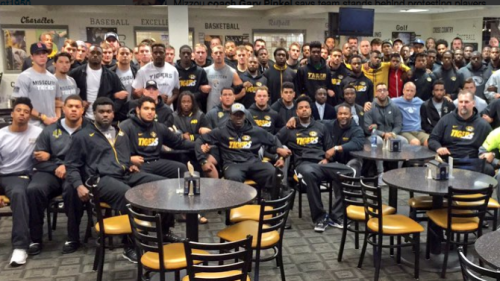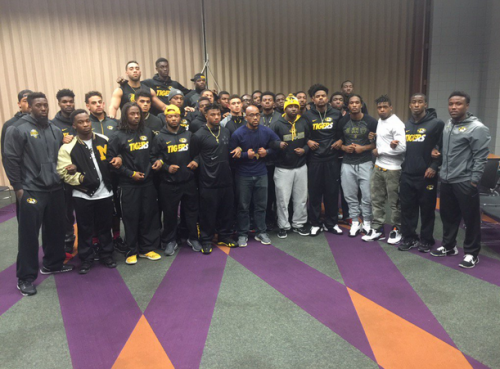Black Student Activists Stand Against Racist Cultures on Campus
Share
Explore Our Galleries
Breaking News!
Today's news and culture by Black and other reporters in the Black and mainstream media.
Ways to Support ABHM?
From Yale to Missouri, college campuses are becoming ground zero in challenging white supremacy and institutional racism.
By Peniel E. Joseph, The Root
The radical spirit of the Black Lives Matter movement touched college campuses this past week in high-profile demonstrations against a culture of racism infecting higher education.
The University of Missouri in Columbia…has become ground zero for black students challenging white supremacy and institutional racism. Remarkably, for 2015, they’ve been joined by members of the university’s football team, who have vowed to go on strike until the school’s president, Tim Wolfe, resigns.

African Americans and their coaches and team members will remain on strike until University of Missouri’s president, Tim Wolfe, resigns. (Photo credit: Gary Pinkel)
Wolfe has been the target of black students who have organized nonviolent actions for racial justice on campus, led by one student who is on a hunger strike to protest Wolfe’s lack of leadership after a spate of racially motivated incidents.
The participation of black student-athletes has drawn national attention and is a hopeful sign of how movement-building over the past year has penetrated the consciousness of the entire African-American community as well as the wider American public…
While students and athletes have united around pursuing the ouster of the university president in Missouri, at Yale University this past week, 300 African-American undergraduates demanded answers from administrators…for failing to combat a pervasive climate of racism.
Black-student outrage partially stemmed from an email written by the associate master of one of Yale’s residential colleges that urged students to be open-minded about racially offensive Halloween costumes. Black students found the message tone-deaf to the almost ritualized pain they experience on campus when white students engage in stereotyping of black culture and bodies.
Black women at Yale have shared stories of racial harassment that seem to illustrate a pattern of anti-black racism on the New Haven, Conn., campus. The visceral pain and outcries of black students led Salovey to admit…that the school had “failed” them…
Some of these same issues confronting black students at Missouri and Yale came into sharp relief for me as I spoke at predominantly white Macalester College… Over 300 mostly black students from surrounding colleges attended the Mahmoud El-Kati Lecture, named after a distinguished retired professor of black studies, who was also in attendance. My talk, “From Civil Rights to Black Lives Matter,” touched on the way in which contemporary Black Lives Matter activists are channeling, in new, important and innovative ways, the organizing traditions of the civil rights and black power era.
The enthusiasm of the young people during and after the speech was extraordinary. Black students…are hungry to understand the history of black struggle in America and globally, and how they can transform the racist culture they encounter on college campuses every day.
The social-justice consciousness of the Missouri football team should be applauded, but the team’s stand against racism is part of a larger national movement that touches every institution in American society.
The #BlackLivesMatter movement’s biggest impact has been in awakening the political consciousness of all Americans, especially students of color. The racial-justice movement exploding on college campuses…is the reflection of a flourishing national movement for the radical political transformation of racist institutions, and echoes the heady years of the black power era, when students of all backgrounds tapped into their power to change the world by reimagining the institutions that surrounded and controlled them.
Black students then, as now, led this charge. This movement continues in our own time in ways that are inspiring civil rights veterans and younger people who have become awakened to racism’s punishing depths and frightening breadth.
Read the full article here.
Read more Breaking News here.










Comments Are Welcome
Note: We moderate submissions in order to create a space for meaningful dialogue, a space where museum visitors – adults and youth –– can exchange informed, thoughtful, and relevant comments that add value to our exhibits.
Racial slurs, personal attacks, obscenity, profanity, and SHOUTING do not meet the above standard. Such comments are posted in the exhibit Hateful Speech. Commercial promotions, impersonations, and incoherent comments likewise fail to meet our goals, so will not be posted. Submissions longer than 120 words will be shortened.
See our full Comments Policy here.